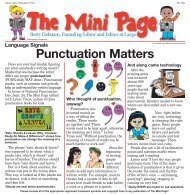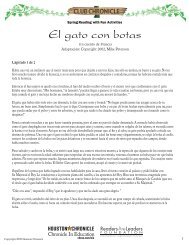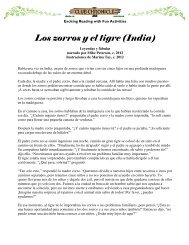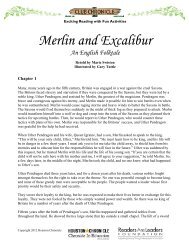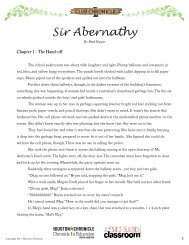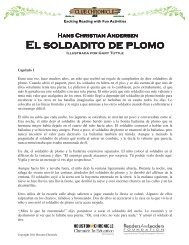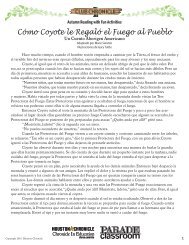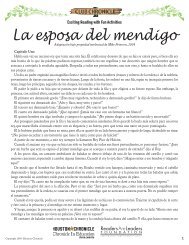Download
Download
Download
Create successful ePaper yourself
Turn your PDF publications into a flip-book with our unique Google optimized e-Paper software.
A Diversity of SpeciesPeople know so much about the Earth,and we learn more every single day.But there's so much we have yet tofully understand, like exactly howmany species of plants and animalsshare our planet with us.Scientists use the word biodiversityto describe the variety of life on Earth,from the tiny microscopic bacteria, towhales, the world's largest animals.So far, scientists have identified 1.5 –1.8 million species (a species is a kindof living thing, plant or animal),including more than 750,000 species ofinsects, 248,800 species of flowers andtrees, 18,800 species of fish, and27,000 species of ocean plants calledalgae. But some scientists think we’veonly found the tip of the iceberg, thatsomewhere between 10 and 100 millionspecies of life can be found on Earth!On Earth Day, people will gatherworldwide to discuss how to preservebiodiversity, to make sure that all theplants and all the animals that currentlylive on Earth stay here forever.Check Out The Newspaper!Learning standard: understanding characteristicsof living things◆ Read through today’s newspaper.Is there a news story about plants oranimals? What is the story about?RedwoodsMonarch ButterflyPandaPolar BearHumpback WhaleFIND & SEEKLook at the pictures of plantsand animals that live here onEarth. Match the picturewith its description andwrite the number on the linebelow the photo. Can youdraw a line from the speciesto the place in the worldwhere it lives? Give it a try!1. A large meat-eaterthat hunts seals and fishin tundra habitats near theArctic circle.2. A large ocean-dwellingmammal that captures largequantities of shrimp-likekrill underwater.3. An Asian mammal thateats only one plant, bamboo.4. A slow-moving plant-eaterthat hangs from trees in theSouth American rainforest.5. The largest trees in theworld, some reachingheights of 200 feet or more.6. A swift-running grassgrazerthat uses whiteand-blackstripes to blendinto its surroundings.7. An nectar-sipping insectthat flies all the way toMexico to spend the winter.ZebraThree-toed SlothANSWER KEY:1. Polar bear, 2.Humpback Whale,3.Panda Bear, 4. Three-toed Sloth,5. Redwoods, 6. Zebra, 7. MonarchButterfly.Extra! Extra! Learn More!1. There are many ways you can helppreserve biodiversity. Your class mightplace some bird feeders outside yourclassroom window to attract and feedbirds. You can even put up bird, batand/or butterfly nesting boxes, availablenow at garden stores.2. Plant a large butterflybush outsideyour classroom window (a gardenstore will know what the plant is).Each year, its nectar-rich blossomswill attract and feed butterflies, andbutterflies are finding it increasinglyhard to find field flowers.3. Learn more about biodiveristy.Contact the World Wildlife Fund andask them about their program,Windows on the Wild.3
Celebrating Earth Day Every Day!HOW EARTH DAY BEGANIn the late 1960s, a series of environmental catastrophes occurred thatscared a whole lot of people. The Cuyahoga River, which flows throughthe city of Cleveland, was so polluted that it caught fire, twice! Amajor oil spill occurred off the coast of California, smearing thousandsof seals and ocean birds with gooey, life-threatening petroleum. Birdslike bald eagles, pelicans and ospreys were disappearing, as pesticidescaused their eggshells to thin, and the thin shells cracked when the motherbird tried to incubate her eggs. Dense smog covered too many cities, theproduct of car exhaust and industrial pollution. Rivers reeked from untreatedwaste flowing out of millions of pipes. Too much human waste poured intowaterways uncleaned. Almost no one anywhere recycled anything.In 1969, Gaylord Nelson, then a United States Senator from Wisconsin,decided to organize a national demonstration on behalf of the environment.During a speech he made in Seattle in September 1969, he announced therewould be a national environmental teach-in in the Spring of 1970. The wireservices carried the story nationwide. The response was dramatic. It took offlike gangbusters.“The objective was to get a nationwide grassroots demonstration of concernfor the environment so large that it would shake the political establishmentout of its lethargy and, finally, force this issue permanently onto the nationalpolitical agenda,” explained Sen. Nelson, former Counsellor to The WildernessSociety, a national conservation group. “It was a gamble, but it worked.”On April 22, 1970, newspapers estimated that some 20 million Americans ofall ages gathered in cities and towns across the country to say one word veryloudly: Enough. Enough pollution. Enough waste. Enough endangered species.That day was christened “Earth Day,” and it changed the world. Two decadeslater, the twentieth anniversary of Earth Day was a global happening ofunprecedented proportions: more than 100 million people participated inevents in more than 100 countries!In October 1993, American Heritage magazine called Earth Day: “… one ofthe most remarkable happenings in the history of democracy…” New laws likethe Endangered Species and Clean Water Acts were passed by Congress andsigned by President Richard Nixon. The eggshell-thinning pesticide DDT wasbanned. The Environmental Protection Agency was founded. Several nationalenvironmental organizations like Friends of the Earth and Greenpeace wereformed, and people began to see the world differently. Recycling programsstarted. Environmental education classes flourished in schools and thousandsof people began tackling projects to protect the environment.“It was truly an astonishing grassroots explosion,” said Nelson. “The peoplecared, and Earth Day became the first opportunity they ever had to join in anationwide demonstration to send a big message to the politicians – a messageto tell them to wake up and do something.”This April 22nd, Earth Day returns, and so many things have changed, somefor the better, some for the worse. Some endangered species like pelicans,eagles and ospreys have been saved. The air we breathe and the water wedrink are cleaner in many places, and more recycling occurs now than everbefore in history. There are many more people working full time in science,government and industry to solve environmental problems. Earth Day hasbecome a day celebrated worldwide.But the problems have not all gone away. There are new endangeredspecies, and endangered habitats, too. Many scientists worry that the Earth'sclimate may be warming. While there is more recycling than ever, there stillis a lot of waste thrown out. And while water and air pollution have beensignificantly reduced, we still have a long way to go.Nelson said, “The future of the environmentdepends on kids asking hard questions, and followinga ‘conservation ethic,’ understanding that everythingon the planet is connected to everything else. We mustalways ask the question: If we mess with nature, whatwill be the consequence, and how can we minimize thedamage?”“The objective of the first Earth Daywas to get a nationwide grassrootsdemonstration of concern for theenvironment so large that it wouldshake the political establishment outof its lethargy and, force this issuepermanently onto the nationalpolitical agenda.“Courtesy of The Wilderness Society4
!TAKEACTION!“No one is too young or tooold to get involved in savingthe environment.”Get in on the action and excitement,and plan a special way for your classand your school to become involved inEarth Day. Here are some ideas.Plan an All-School1. GatheringBegin Earth Day with an outdoorgathering around the school’s flagpole. Under the American flag, hoistan Earth flag, as is done at manyschools. Work with your teacher andmusic teacher to create an Earth Dayceremony that includes an environmentalsong sung by the whole school,environmental readings and poems,and perhaps ends with the unveilingof the school's newly planted tree.2. ParadePlan a parade, involving your entireclass or your entire school, celebratingEarth Day. Dress up as hundreds ofdifferent species of plants and animals.Create floats out of recycled materialthat teach about the environment andenvironmentally responsible actions.Each float could represent a differentnatural habitat or you could havemarching habitats, like rainforests andreefs, and involve the school marchingband in some novel way.Community3. ServiceCall a nature center, park or localenvironmental group to volunteer yourclass time on Earth Day. Help themclean a park or creek, or improve theenvironment in some other notableway. Write to the local press to letthem know what you are doing.4. TestifyEvery town, suburb, city, and ruralarea has some form of local government,a Mayor and Town Council orBoard of Commissioners. Every schoolis governed by a School Board. Someof these officials are elected representatives.Find out when their nextpublic meeting is and how they invitepublic testimony. Have a group ofstudents in your class write a statementabout Earth Day. Ask your towngovernment to endorse Earth Day andplan a special commemoration. Askthe School Board to adopt a trashreduction or energy conservation plan.Make sure you have discussed anytestimony with your parents, teachers,and principals.Write to the5. NewspaperCheck out this newspaper’s letters tothe editor column. In small groups,read two or three aloud. What arepeople writing about? Do you agree ordisagree? Write a letter to the editor,using the format, and following anyguidelines described on the letterspage. Send the letter(s) to the newspaper.Are they printed? Are there anyletters sent to the newspaper thatcomment on your Earth Day ideas?Check Out The Newspaper!Learning standard: understanding the importanceof the environment◆ Read today’s newspaper, especiallyits news sections. Is there any newsabout Earth Day? News about theenvironment? What stories have youfound? Are they good news or badnews about the environment?Extra! Extra! Learn More!1. If your class is connected to theInternet, conduct a search on the webfor the phrase “Earth Day.” Can youfind organizations dedicated to promotingEarth Day? Can you find EarthDay activities for schools and families?2. Interview a parent or grandparentabout what they remember about thefirst Earth Day in 1970. Write a reportabout their memories of Earth Day.3. Learn more about Earth Day, theconservation ethic, migrating birdsand the lands that all Americans ownat The Wilderness Society’s website:http://wilderness.org.4. Write a letter to the WildernessSociety letting them know about yourhopes and concerns for ourplanet, and how you want to helpimprove the environment. Send ane-mail message to them.Sen. Gaylord NelsonMAKE YOURVOICE HEARD!http://earthday.wilderness.org5
10GoodThingsAboutTREESA tree’s fruits, leaves,twigs and bark provide___________________for many living things, fromacorn-eating blue jays toleaf-chewing deer tobark-gnawing beaver.Trees help us in so many ways, and so much of the Earth was once, and still is, covered by forests and trees.Once, it is said, a squirrel could walk across tree branches from Maine to the Mississippi River, and nevertouch ground. Forests worldwide are troubled by a variety of problems, from too much cutting and clearing totoo much pollution.In response to this problem, many schools plant trees on Earth Day. That’s because one tree does so manythings to improve the environment and help nature.Here’s a tree growing on this page. On each leaf is one good thing a tree does to help ecology. Fill in theblank on each leaf by using one of the words on the word list at the bottom of the page. Work alone,then read answers aloud. After you’ve filled in the blanks, discuss which ofthese 10 things a tree does is the BEST! thing abouttrees. Divide into groups of three, and have eachgroup reach consensus on the best thing abouttrees. Share your ideas with the whole class.The wood from trees makesfurniture, homes, toys and even_____________________like the one you are writing onright now.A tree’s shade coolsthe environment inthe summer, andacts like a natural air_________________during the hottestmonths of the year.A tree’sleaves filterthe air, removing air__________________and making the air cleaner,more breathable.A tree is a _____________ formany living things, its branches andtrunk providing ants, bees, squirrels,birds, raccoons, opossums, bats andso much more with places to live.A tree's green___________________produce oxygen for us to breathe.Trees help make air for you andall animals.6Trees provide great placesfor kids to ____________.You can climb its trunk, swingfrom its branches, picnicbeneath its shade andmore.Trees produce foodfor people, too:coffee, oranges,lemons, cherries and______________all come from trees.A tree grows_______________deep into the soil, which help to holdthe soil together and prevent erosionduring rainstorms.When leaves fall offtrees in the__________________,they decompose to make new soilfor growing new flowers and newtrees in the spring.Word List:❏ Paper❏ Food❏ Play❏ Home❏ Conditioner❏ Roots❏ Autumn❏ Pollution❏ Leaves❏ BananasExtra! Extra! Learn More!1. Make a series of large postersabout good things trees do, based onthe statements in these leaves. Hangyour posters around the class, or inyour school hallway.2. Discuss the possibility of your classconducting a tree-planting for EarthDay. You’ll need permission from theprincipal and even the groundskeepersof your school system, who can oftenrecommend the right kind of tree toplant. Talk to a local park or naturecenter about planting a tree there,perhaps, or plant a shade tree along atreeless section of a local street. Talkto a garden supply store about thepossibility of having the tree donated.Check Out The Newspaper!Learning standard: analyzing an environmentalproblem◆ Read the Dr. Seuss book, The Lorax.What does this special book say abouttrees? After reading some letters tothe editor in today’s newspaper, imagineyou are one of the characters inthe book. Write a letter to the editorof the local newspaper telling how youfeel about the trees and the thneeds.
Ahhhh, Water!Riddled with WaterWe drink it, swim in it, cook with it, bathe with it, wash our cars with it, waterthe garden with it. Nothing on Earth is used in as many different ways as water.In fact, you don't even see how most of the world’s water is used: to irrigate farmcrops, to nourish the thirst of cattle, to cool electric generating power plants, tomine gold ore out of rock, and to help make everything from copper coins to computerchips.Luckily, the Earth is blessed with an abundance of water, about 100 billion billiongallons of water. Most of that (97%) is in the oceans, and two-thirds of theworld’s fresh water is locked in the polar ice caps!But, there are many problems with water. Before 1970, there was very littleclean-up of the world’s waters. Many pipes dumped chemicals and raw sewageright into waterways. The first Earth Day helped change that. Congress passed aClean Water Act in 1970 right after Earth Day, resulting in less pollution inAmerica's rivers. Still, there is much work to be done. Our rivers and streams arestill not fully clean and each of us needs to do our part to conserve this importantresource.On Earth Day, consider how you use water, and how you can help the worldconserve water by using it more carefully. To best conserve water, you first need toknow how you use water. According to the US Environmental Protection Agency,the typical family of four consumes 243 gallons of water every day!Can you guess which single use of water in your home represents 100 gallons ofthat, almost half of a family's water? The largest user of household water can bediscovered by reading each of the riddling rhymes below. Write the correctanswer in the space provided, one letter in each blank. Remember, the answersmust rhyme! Use the numbered letter to solve the mystery water use; the first letteris provided for you.It’s the:_____T_____ _____ _____ _____ _____1 2 3 4 5Using this faucet, you gotta understandA family does much more than scrub its handsFood is washed, water is poured to drinkA family uses five gallons in the kitchen ___ ___ ____ ___2To keep teeth shiny, to make them glowTo make sure cavities will never growIn a bathroom sink, eight gallons will rushWhen a family of four uses its____ ____ ____ ____ ____ ____ ____ ____ ___ ____5Some do this in the morning, some at nightYou come out looking clean and brightThe soap might help you smell like a flowerBut families use 80 gallons per day in the ____ ____ _____ ____ ____ _____1You hate to do it, but you’ll be a real winnerWhen you volunteer to do this after dinnerYou’re taking water away from fishesWhen you use 10 gallons a day to wash ____ ____ ____ ____ ____ ____4When shirts get dirty, when socks smell phewYou know exactly what you have to doIn a washer, 30 gallons flows through the hoseEvery day your parents wash your ____ ____ ____ ____ ____ ____ _____3Discussion: If a family of four wishes to do ONE THING to conserve the amount ofwater their family consumes, what might that be? Which one change in how yourfamily uses water might have the most benefit?Extra! Extra! Learn More!1. Use the numbers provided on thispage to create a bar graph of wateruses. Be sure there is a bar for eachof the following home uses: ToiletFlushing; Shower/Bathing; Laundry;Dishwashing; Bathroom Sink; KitchenSink.2. A dripping faucet can add as manyas 50 gallons per day to a household’swater consumption. Watering a gardenor lawn can add another 100 gallons ofwater! What would a family’s totalconsumption be if you added those twonumbers to 243 gallons?3. Where does your school’s watercome from? A river? A well? Howabout your home? How can you findthis out? Choose someone from theclass to call your local water companyto find out the water source for yourcommunity. Have the utility companysend materials to your class. Considerinviting someone from the company totalk about water for Earth Day. Askthe water company representative torecommend ways for you to conservewater both at school and at home.Check Out The Newspaper!Learning standard: understanding factors thataffect the weather◆ Look for the weather informationin today’s paper. Can you find out howmuch rain has fallen in your area thisyear? Is that more or less than average?Check the weather information for thenext few days. See if you can find outwhere in the country it is raining themost this week.◆ Look through the newspaper to findout if the weather made the news.Write a summary of any weather newsstory you find.◆ Locate the national weather map inyour newspaper. How does the weatherin your town compare to other placesaround the country?7
Searching for CluesSearching for SolutionsUnscramble the letters of the namesof the endangered species to solve thepuzzle. Then, divide your class intogroups, and assign each group one ofthe species. Find library books aboutthe animals and conservation effortsto save them. Write group reportsabout what you have learned. Presentyour findings to your class.NATURALWINNERS!?In 1970, one of the biggest worries of those organizing Earth Day was the disappearanceof species. In fact, the first Earth Day led Congress to pass theEndangered Species Act, which gives the federal government the right to namespecies as rare, threatened or endangered, and provides protections for plants andanimals on the list.Brown pelicans, buffalo, peregrine falcons, American alligators, bald eagles andtimber wolves were animals people wanted protected quickly, for the numbers ofeach were declining quickly. Not only did the law make it illegal to hunt theseanimals, but the law required state and federal wildlife officials to devise plans toproduce larger numbers of these animals. More than 30 years later, the numbersof each of these animals has increased dramatically.Below are eight more endangered species. They are deeply in trouble. Thesuccess stories of their survival depend on caring and persistent conservationefforts. Think about how you can be part of the solution.Check Out The Newspaper!Learning standard: recognizing the need toprotect endangered species◆ Are any of the endangered specieslisted here found in the communitywhere you live? Are local groups organizedto protect them? Write a letterto the editor of your newspaper lettingthem know what you think aboutprotecting this animal. Use the editorialpage to see how they are written.MORE THINGS TO THINK ABOUT◆ More than 1,000 species are on theendangered species list. How manyhave been removed from the listbecause their situation improved? Isthat better or worse than you’d expectafter 30 years of listing species?◆ What do you know about wolves?Would you mind a wolf pack living in aforest near your home?Photos: U.S. Fish & Wildlife Service and NationalOceanic and Atmospheric AdministrationANSWER KEY:1. Orangutan, 2.Black Rhino, 3. WhoopingCrane, 4. Cheetah, 5. Shark, 6. Grizzly Bear,7. Tiger, 8. Manatee.81. A large ape native to Southeast Asia G N A T O R U N A2. A very rare, fast-charging grass grazer C L A B K H I R O N____ ____ ____ ____ ____ ____ ____ ____ ________ ____ ____ ____ ____ ____ ____ ____ ____ ____3. A stilt-legged American wading bird P H O N I W O G R E N C A4. The fastest cat on Earth T H E A C H E5. The biggest fish in the ocean H A K R S____ ____ ____ ____ ____ ____ ____ ____ ____ ____ ____ ____ ________ ____ ____ ____ ____ ____ ________ ____ ____ ____ ____6. A giant of the American West Z R I L Z G Y R A B E7. A striped Asian predator G R I T E8. A slow-swimming Floridian T A N A M E E____ ____ ____ ____ ____ ____ ____ ____ ____ ____ ________ ____ ____ ____ ________ ____ ____ ____ ____ ____ ____
Below: Fan coral off Grand Cayman, John Roseborough,NOAA. Left: Coral Reef off Grand Cayman, JohnRoseborough, NOAA.P ICTUREOnce environmental issues wereconsidered local problems. Peopleworried about pollution near theirhomes. They wanted this smokestackcleaned, that pipe to stop pumpingpollution. In 1970, people wanted topreserve species like eagles, pandasand grizzlies. These were and are alladmirable goals for the environmentalmovement.But today, because of advances inscience, computers and TV, air traveland e-mail, we can know instantly howwhole ecosystems around the worldare doing. Whether they are thrivingor barely surviving. This instant globalknowledge is a big change from thefirst Earth Day.The result has been that instead ofdemanding protection for a singlespecies, more people are demandingthe protection of whole habitats. Thefocus on habitats has brought muchattention to the dilemma of rainforestdestruction. You can learn more aboutit in a story on page 3 of this tabloid.But, a lesser known habitat is alsobeing threatened. The oceans’ coralreefs. Like rainforests, reefs are valuableresources and important parts ofthe global ecosystem. Coral reefs haveoften been described as “underwatergardens,” with their beautiful colors,intricate shapes and exotic creatures.Yet, despite their ecological importanceand beauty, the reefs are beingthreatened around the globe byhuman activities such as coastaldevelopment, overfishing and pollution.Worldwide, the coral reefs aredying and disappearing. And, as withthe rain forests, it will be up tohumans to stop the damage and learnhow to protect coral reefs for futuregenerations.T HIS...How can you help?All of the human threats posed tocorals can be reduced. By using thebest available technologies in powerplants, oil tankers and sewage treatmentfacilities, the effects of disturbanceand pollution can be lessened.Increased public education can reduceand eliminate the damage caused bypollution deforestation, fishing andother human activities. Use your voiceto promote conservation. Make youractions support your good intentions.The Center for Marine Conservation(CMC), is working to help createmarine sanctuaries in which humanactivities are regulated and marineecosystems, such as coral reefs, canprosper. The organization is dedicatedto the protection of marine life, andstrives to increase public awareness ofmarine conservation issues. CMC waspart of a successful effort to have theFlorida Keys designated as one of ournation's largest marine sanctuaries.Top: Boothbay Lab, NOAA. Above: Brain Coral, Center forEnvironmental Education, James H. Yelvington.Below: Cyanea, NOAA, Auster.Above: Sea star. Below: Sea Anemone, NOAA. Bottom: Crab.Check Out The Newspaper!Learning standard: creating graphic representationsThings to do!1. Become a reef artist and explorer.Use the photos of real coral reef creatureson this page to create your owncoral reef picture or model. Add one oras many of each to your reef as youlike. Learn more about the reef andadd more species. Color your creationwith bright, lively colors because coralreefs are among the brightest placeson the planet.2. Find out what coral is. Is it a plantor an animal? Write a research paperon corals. Describe their life cycle andthe danger posed to coral reefs.Include drawings.Extra! Extra! Learn More!Find school or public library books tolearn more about the coral reef. Usecomputer encyclopedias or perform anInternet search for reef information.Visit the websites of these two organizationsthat concentrate on coral reefconservation.Center for Marine Conservationhttp://www.cmc-ocean.orgThe Coral Reef Alliancehttp://www.coral.orgPlease note that websites often changeAbove: Purple SeaUrchin, Center forMarine Conservation,Ron Schmeider.Right: Sea Foam,Center forEnvironmentalEducation.Left: Rox Anemone, Center forEnvironmental Education, RonSchmeider.9
Power from the PlanetLook around your classroom: how many uses of electricity can you find? Are thelights on? Is there an electric pencil sharpener? What else do you see?On Earth Day, it’s important to remember that electricity fuels our lives, and allelectricity comes from the Earth’s resources. Power plants run by making steam,(from boiling large amounts of water) and using the steam to turn a turbine andgenerate power. Some power plants run by burning coal mined from the Earth.Others burn oil, drilled from the planet. Still others run by nuclear power, whereuranium ore, a radioactive mineral found in the Earth, heats water as its atomssplit.In 1970, people wanted power plants to burn more cleanly. At the time, coalfiredpower plants poured large amounts of soot, ash, waste and heat into bothskies and waterways. Today, power plants are required to burn more cleanly, inpart because of laws like the Clean Air Act passed after the first Earth Day.Still, using electricity generates pollution. When a light switch or a TV set isturned on, it uses electricity. The electricity comes to your house over wires fromthe power plant. To make the electricity, ore is mined, which can harm habitats.Fuel is burned, and even though a smokestack pollutes less than it once did, itstill emits some possibly harmful chemicals. Power plants also release gases likecarbon dioxide that, some say, may be harming the Earth’s weather systems. Allpower pollutes, and conserving energy is an important way to help the Earth’s environmental systems.Examine the picture of a girl in her home. Can you find at least ten uses of electricity in this picture? Write them in thespace provided on the right.Now, let’s imagine your parents suddenly announce you are moving to a log cabin in the woods to start a new life.Unfortunately, the cabin will only have a small generator, and you can only take 3 uses of electricity with you! Read your list ofdevices that use electricity again carefully. Circle the three things you think your family should take.Next, let’s see how your choices compare to your classmates. Divide the class into groups of 3 or 4. Pretend each group is afamily heading to a cabin. Each family can take only three electrical appliances to the cabin. Figure out how to decide whichthree your family will take. Hint: Have each member of the group read their list aloud. Discuss which three things you couldor should bring. If you choose NOT to bring something important, decide what you will do to replace what that appliance doeswhen you get to the cabin. Now have each group choose a presenter to share their “family’s” final listwith the class.The final challenge: See if the entire class can decide which three things to bring. Good luck!Uses of Electricity1.2.3.4.5.6.7.8.9.10.10
BuildaGarbagePizza........Every day, says the Environmental Protection Agency,every American (that includes you, and everyone else inthe class)-- produces a little more than four pounds ofsolid waste. Every minute of every day, garbage trucksall over the world carry solid waste somewhere, loadedwith day-old newspapers, orange peels, grass clippings,coffee grounds, pizza crusts, cigarette butts, unwantedtoys, stale bread, soda cans, broken refrigerators, milkcartons, cardboard boxes and so much more.We bury solid waste in landfills, burn it in incinerators,recycle it back into useful products and sometimes evencompost it by turning it into soil.Check out the table below. It represents the differentcategories of solid waste the average American throwsaway, listed in order of weight for each category. First,find the total amount of trash the average person disposesof annually. Then, examine the pie chart. Perhaps youhave studied pie charts in math class or your teachercan show you how to read them.Your job is to label all the slices of the pie accordingto the kind and amount of solid waste the average personuses every year. Two hints: the largest slice representsthe largest source of solid waste; the smallest slice thesmallest source of waste. Can you fill in all the blanks?Now, if every person in your class throws away 4pounds per person, how many pounds of trash does yourclass dispose of every day? Every year? How manypounds does your school produce annually?Here’s an idea for a special Earth Day project: build aGarbage Pizza in your schoolyard. (You’ll need both yourteacher’s and principal’s permissions.) Use chalk todraw a very large circle on the asphalt. Can you figureout a way to both draw a giant circle and create theright-sized slices on your circle? Collect large amountsof items to represent each slice of the pie – piles ofnewsprint for the paper slice, aluminum soda cans forthe metal slice, etc.With your teacher, discuss how much of each itemyou will need, how it will be brought to school and howit will be handled safely. You might want to use plasticsoda bottles for the plastic slice, but your class certainlyshould not pile food scraps in food waste section. Be creative.What might you use to represent the idea of foodwaste?Once you have arranged the display of trash piled upin your Garbage Pizza, provide tours of your pizza toother classes or community groups. Call newspapersand TV stations to give them information about yourproject, and see if they will do a news or feature storyabout your project. Or, take your own photos and write astory to submit to the newspaper.Be sure to plan what to do with the materials youhave collected after Earth Day. Can you recycle theentire Garbage Pizza when Earth Day is over?...Solid WastePounds of solid waste per person in one year.Food WasteMetalGlassPlastics.Yard WasteRubber, Leather, ClothWoodMiscellaneous.Paper..Extra! Extra! Learn More!1. Arrange for your class to tour asolid waste treatment facility, a landfillor an incinerator. Discuss the tripafter its conclusion.2. In the entire United States, only alittle more than 10% of solid waste iscurrently recycled. If paper, metal,glass, plastics and cloth are recyclable,and if yard waste, food waste andwood can be composted, what percentof solid waste can be reclaimed, andnot incinerated or buried? Doeseveryone in your class recycle all theycan? Why or why not?Check Out The Newspaper!Learning standard: developing a plan toconserve resources◆ Look at the editorial cartoons in thenewspaper. Draw a cartoon thatexpresses your opinion about the trashsituation in your school. Are kids carefulabout the amount of waste at lunchor could they do a better job? (Hint:check your lunchroom or cafeteria forsome illustration ideas.).11
Seeds of ChangeOn Earth Day, it’s important toremember what happened toSquirrel. That’s right, Squirrel,a neighbor of yours with a story to tell.Here’s a short play for Earth Day, aplay to be read aloud by your entireclass. Divide the class into five groups:Squirrel, Water, Soil, Air and Sunlight.Choose a Narrator and an Acorn. Havethe characters read the parts aloud.So, get ready on the set. And, ACTION!Narrator: Once upon a time, there wasa forest filled with trees: dogwoodsthat bloomed beautifully, spicebushthat smelled sweetly, pines that grewstraight and tall, oaks laden withacorns.Water: As the rains fell on the forest;Air: As the winds blew across the forest;Sunlight: And as the sun shone brightlyupon the forest;Soil: Seeds sprouted from the richbrown earth, growing wildflowers andweeds, shrubs and trees of all colors,shapes, and sizes.Narrator: And the trees and plantsprovided homes, food and shelter for abewildering variety of animals.Water: Trout lived in the forest'sstreams, eating the mayflies and themosquito babies that lived underwater.Raccoons came to its water searchingfor crayfish and frogs, birds calledkingfishers dove into the water tospear their prey.Air: Hummingbirds hovered in thesummer air, blue jays squawkedthrough its branches, butterfliesfluttered among the flowers, batsskimmed the night air in search ofmoths.Soil: Turtles laid eggs deep in theearth, moles tunneled underground insearch of earthworms, foxes raisedpups in burrows stolen from the woodchucksthey devoured, chipmunksslept underground during the coldwinters.Sunlight: And the sun shined on it all,fueling the life that lived in the forest.Narrator: Everything in the forest wasused wisely and used forever. Nothingwas wasted.12Air: Animals breathed air, inhalingoxygen into their lungs,burning the oxygen, and takingit from the air.Narrator: But plants alwaysmade new oxygen, and thecycle continued.Soil: Plants took nutrients from thesoil, growing taller and taller, buildingthemselves out of the very earth itself.Narrator: But trees shed their leavesin the fall, and wildflowers witheredand died. Their decaying leaves andbodies made new soil, more soil, fornew trees and new flowers.Water: Animals drank the water,removing it from creeks and streams.Plants pulled water from the soil, theirthirsty roots continuously drinkingfrom the soil.Narrator: But the rains always came,bringing new water to the forest.Sunlight: And when the sun’s energywaned in the winter, no one worried.They all knew that spring would come,that the sun's fierce rays would oneday return, and grow the forest again.Narrator: And so the world worked,flowing in cycles, air, water, soil andenergy all renewed in the circle of theseasons.Squirrel: Until the squirrels came.Now, there’s one thing you shouldknow about squirrels.Air, Wind, Water, Sunlight (together):What that?!Squirrel: Squirrels are hungry, veryhungry. We just LOVE to eat. In a forest,we’ll eat just about anything: budsand flowers, walnuts and hickory nuts,sumac seeds and maple seeds, leavesand twigs. But squirrels love one thingmore than anything else.Acorns: Acorns for breakfast. Acornsfor lunch. Acorns for afternoon snack,and for dinner, and at bedtime.Narrator: Ah, acorns, the fruit of theoak tree. Oak trees, one of the mightiesttrees in the forest, big of limb andstrong of build, all begin life as acorns.Squirrel: And all acorns end up in mystomach. Why, this forest has so manyacorns, I simply must call all mybrothers and uncles and aunts andcousins and invite them to move intothis forest.Narrator: So the forest was soon filledwith squirrels, all happily eatingseeds, fruits, leaves and branches.Water: And when the rain fell, noacorns sprouted, for they all had beeneaten.Air: And when the wind blew, noacorns grew, for they were gone.Sunlight: And when the sun shined,nothing sprouted from earth, for therewere no seeds.Soil: And as fewer seeds grew, the soillost its richness, and became lifelessand barren.Narrator: As oak trees died, fewer oaktrees grew to replace them, feweracorns sprouted to become new oaks.Air, Wind, Water, Sunlight (together):The squirrel had eaten its future.Narrator: So the squirrels began tohoard their acorns, and hide themfrom each other.Squirrel: I’ll make sure the othersquirrels don’t find these acorns. I’llbury them in the ground, hide theminside holes in trees, place themunderneath stumps, any place theother squirrels won’t look.Air: Luckily, the squirrel buried moreacorns than it really needed.Water: So when springtime arrived inthe forest,Sunlight: And the sun rays warmedthe frozen, lifeless earth,Soil: The acorns the squirrel had hiddenin the ground began to sprout.Narrator: The squirrel noticed newoak trees growing from the earth.Squirrel: So that’s where those acornswere.Narrator: And the squirrel consideredeating the newly sprouted oaks.Squirrel: They would taste great, but ifI let these grow, perhaps there will bemore acorns a few years from now.Narrator: Which is what the squirreldid. The squirrel struck a deal withthe oak trees. The oak would producelots of acorns, millions of acorns.Air: And the squirrel would eat a lot ofthem.Sunlight: But not all of them.Water: No, for the squirrel needed oaktrees to produce acorns, its favoritefood.Soil: And the oak trees needed squirrelsin return, for it became the squirrel'sjob to grow oak trees.Squirrel: So every fall, I bury lots ofacorns, some for me, but some for theforest.Narrator: And that’s the way the forestcame back. The squirrel took what itneeded to stay alive.Squirrel: But I made sure to give backto the forest that sustained me.Narrator: So should we all live, givingback to the Earth that keeps us aliveWater: We all drink water, use water,consume water. But how do we giveback to the water we need?Air: We all breathe air, burn oxygen.But how do we give back to the air weneed?Sunlight: We all use sunlight energyfor power, light and heat. How do wegive back to the energy that sustainsus?Soil: We all eat food grown from thesoil, use trees cut from soil. How dowe give back to the soil that nurturesall life?Squirrel: Like me, everyone can plantacorns.Narrator: Acorns: good works. Seedsof change. Small deeds that protect amighty planet.Air, Wind, Water, Sunlight (together):What acorns have you planted today?Now plant an acorn!Things to Do!1. Write the word “ACORNS“ on thechalkboard. Below the word, brainstorma list of good deeds that helpthe environment. Any good environmentalact is an acorn.2. Brainstorm a list of good deedsthat help other people, and mighthave little to do about nature, ecologyand the environment. Are good deedsimportant? Which good deeds havestudents in your class done?3. Draw a large picture of an acorn.Inside the acorn, write the followingstatement: “This Earth Day, to helpimprove the planet, I am going to....”Complete the sentence any way you’dlike. Choose any acorn, any good deed,you think you’d like to do.4. Share your acorn with one otherstudent.5. Make sure you perform your acornact on Earth Day.Check Out The Newspaper!Learning standard: providing solutions toenvironmental problems◆ Search today’s newspaper for astory about a good deed-- somethinggood someone did to help other people,animals, plants, or the environment.What is the story about? Whatdid the person do?
DRIVE POLLUTIONAWAY!During the first Earth Day, peopleprotested about cars. They said carscreated too much pollution, that carexhaust choked the air. Highways builtonly for cars were ruining too manyhabitats like forests and fields. Toomany resources were used for producingcars.With time, cars have changed.Before the first Earth Daylead was an additive ingasoline. And whilelead helped cars runsmoothly, it poisonedthe air, because it isa very dangerouschemical forpeople tobreathe. Now,most cars run onunleaded gasolineand more hybridcars, using alternativefuels, are beingbuilt. Cars run cleaner, moreefficiently, producing less pollution,using less gas. Some car manufacturersare even experimenting withrecycled and re-used parts.Still, few things affect the environmentquite like a car. People are nowdriving more cars than ever and longerdistances than ever, adding to urbansmog. Check out the drawing to findall the different ways a car causespollution.Here’s your job.In groups of 3-4, invent the car of thefuture, a car that creates little or nopollution. How does it run? What is itsfuel? Of what materials is it made?Use the worksheet on this page tohelp you and your group design yourcar. Then give your car a name.Draw large poster-sized ads foryour cars, and display them in yourschool’s hallway.Or create TV ads, and performthem for each other as skits.Cars kill billions of flying insects, includingimportant pollinators like butterflies and bees.Cars run over thousands of wild animals,including skunks and snakes, raccoons andrabbits.WORKSHEET:Car’s Name:Year it’s produced:Your car company’s name:Your ad slogan:List five ways your car helps improve the environment:1.2.3.4.Air conditioners often use chemicalsthat, if they leak, assist in harmingthe atmosphere's ozone layer.Cars are made from metal, requiring tons ofore to be mined from the ground, harminghabitats worldwide.Cars must be parked somewhere,requiring millions of acres of landfor paved-over parking lots.Wait a Minute!Car exhaust createssmog and releasesgreenhouse gases thatmight be warming theworld.Cars run on gasoline, andthe production of gas emitspollution into air, water, andsoil. Gas stations and theirunderground storage tanksleak tremendous amountsof gas into the soil, whichpollutes drinking water.Mountains of car tires are tossed into landfills orburned each year. Burning tires emit massiveamounts of air pollution.◆ If cars do all these things – dirtythe water, warm the climate, kill animals– why do we drive them? Is thereanything useful that cars do? Write astatement below about one good thingthat cars do. Share your statements inyour group. What's the best thingabout cars?Check Out The Newspaper!Learning standard: developing marketing strategies1. Look through the car ads in thenewspaper and create an ad for yourcar based on the ones you read.2. Search through the newspaper’sadvertising. Seek out ads that promoteproducts that help improve the environment.Clip out and create a bulletinboard collage. As a class, vote for themost environmentally friendly product.5.13
PLUGGING INTO THE PLANET?1. The source of the drinkingwater that flows into myhouse is:a. A riverb. An underground wellc. A reservoird. I don't know2. When the trash truck picksup my house's solid waste,the destination for that wasteis:Test what you knowa. The oceanb. A landfillc. A solid waste incineratord. I don't knowTo help care for the environment, there are many things you shouldknow. One of the most important is how you personally use theresources of planet Earth, how you are plugged into the planet everyday. Here are some questions about how you connect to the Earth’sresources. Try to answer these questions by yourself first. Circle theletter of the choice you think is correct. Then, share your answers asa group. Discuss with your classmates why you believe your answer iscorrect. Don’t worry if you don't know all the answers, you're notbeing graded. If you’re stumped, take this test home with you and askyour parent or someone else at home about the answers.3. When I flush the toilet in myhome, the water flows into:a. A septic tankb. The sewer systemc. I don’t know4. The lights that glow in thisclassroom use electricitymade by the local powerplant that uses:a. Coalb. Oilc. Nuclear fueld. Hydropowere. I don’t know5. My family recycles which ofthe following items?a. Aluminum cansb. Glass bottlesc. Newspapersd. All of thesee. None of these6. Which of the followingactions causes pollution?a. Watching TVb. Driving a carc. Flushing a toiletd. Eating a hamburgere. Buying a bookf. All of these7. Which of the followingactions lessens pollution?a. Walking to schoolb. Recycling glass and metalc. Taking short showersd. Planting a treee. Reusing paperf. All of these8. Many scientists are very worriedabout the disappearanceof plants and animals. Thebiggest reason animals arevanishing from the Earth is:a. Illegal huntingb. Chemical pollution inair and waterc. Habitat lossd. Forest firesANSWER KEY:Answers 1-5 depend upon where you live. Thereis no one correct answer. New York City residentsmight get their water from CatskillMountain reservoirs; Miami residents fromunderground wells. 6: f, All cause pollution –TV sets need electricity from power plants; thetoilet’s water needs cleaning, a process thatrequires noxious chemicals; hamburgersrequire cattle ranching, which seeps hugeamounts of waste into waterways; a book ismade from bleached paper, and the bleachleaches into waterways. 7: f, Walking cutsdown on auto/bus emissions; recycling conservesenergy, saving on power plant emissions;short showers require less water to be cleaned;trees remove pollutants from the air; recyclingand reusing paper means fewer trees need tobe harvested. 8: c, Especially in rainforestsand coral reefs.14
Pol l i ng the PlanetAt the first Earth Day in 1970, people gathered together to advocate localpollution controls. Residents of Cleveland demanded the clean-up of theCuyahoga River, a river so polluted with petroleum-based chemicals that itssurface caught fire and Lake Erie, one of the Great Lakes, almost devoid of allfishlife. In New York City, protests focused on the city’s smog and the fishkills onthe Hudson River. People in Pittsburgh wanted their city's infamous air pollutionreduced. In Los Angeles, well known for its fierce lung-choking smog, peopleadvocated for cleaner air.The good news is that many smokestacks have been cleaned, and the Cuyahogaand Hudson Rivers, as well as Lake Erie, are far less polluted. Still, there continueto be many issues to discuss, learn about and act upon.But today’s environmental issues are very different. Many are global in scope.You may have read about global warming, the possibility that the Earth's climateis increasing and becoming hotter, due to an increase in atmospheric gases likecarbon dioxide, generated from cars, buses, factories and power plants. Peopleare also working on ozone depletion, a seasonal lessening of the amount ofozone in the atmosphere high above Antarctica. And, due to the release ofozone-eating chemicals like CFCs (chlorofluorocarbons) from air conditionersand refrigerators, moresolar radiation shinesthrough the atmosphere.This conditionincreases the riskfor skin cancer thatwe all face.Habitat loss is another global issue scientists and environmentalists areaddressing. Many habitats are in trouble. We must prevent habitat loss in order toprevent the loss of biodioversity – the decline in the number of species inhabitingour planet. Ecologists are working hard worldwide, hoping to save natural habitatsthat include the coral reefs, rainforests and prairies.The problems and challenges of rainforest preservation are a good example.Much of the tropical landscape is covered by rainforests – huge expanses of landthat include many species of plants and animals. Rainforests around the world aresuffering from numerous threats, especially from being burned down to createfarmland. Of course, the people who live alongside the rainforests need food to eatand money to live. Unfortunately, many of them burn down the rainforests inorder to turn the area into farmland. But, the land is not really good for farmingand after a few years, they desert the land, having destroyed the rainforest. Realrainforest preservation must include finding ways for people who live near theseforests to grow food and earn a living while keeping the forests intact.Here’s your job.Below is a list of 10 environmental issues. Rank each issue in order of importance.Give a number 1 to what you think is the most important environmental issue ofall, a number 10 to the least important issue. Fill in all the blanks in between.Write your ranking on the line next to each one.Next, compare your answers as a class. Work with your teacher to compute anaverage score for each listing. Remember, since 1 is the most serious, the mostimportant issue will have the lowest average. Which issue does your class considerthe most important? Which the least? Talk about the difference between leastimportant and unimportant. Are any environmental issues really unimportant?Now devise a way to take a poll of 100 students in your school. How does the100-student poll compare to your class results? Do a poll of 10 adults in yourschool. Do the adults and kids in your school agree on the most important issue?Try to explain your results. How and why are they the same or different?______ Too much litter on roadsides and in public parks.______ The decline in the number of species living on Earth.______ The creation of too much solid waste, with too little recycling.______ The hole in the ozone layer from the release of CFCs.______ The possible warming of the planet’s climate from greenhouse gases.______ The pollution of rivers, streams and oceans from both industry andhouseholds.______ Loss of natural places as land is developed into malls, roads, and houses.______ The pollution of the air, especially during the summer, from urban smog.______ The loss of important habitats, like rainforests, coral reefs, wetlands,and old growth forests.______ The creation of too many dumping grounds from toxic chemicals.Other:Check Out The Newspaper!Learning standard: exploring the interrelationshipsof habitats and organisms◆ Can you find news stories abouthabitat conservation and biodiversity?◆ Write a letter to your newspaperabout the results of your school poll.◆ Find articles in the newspaperabout the environment.◆ Write a letter to the editor of yournewspaper about what you see as themost important conservation issue inyour community.◆ Compare how your newspaper andthe tv news cover an environmentalnews story. Discuss with your classhow they are different and the same.15
Kids and ConservationCheck out these great websites.EarthForcehttp://www.earthforce.orgKids Against Pollutionhttp://www.kidsagainstpollution.orgKids F.A.C.E.http://www.kidsface.orgThe Natural Guardhttp://www.treesit.orgNational Audubon Societyhttp://www.audubon.comThe Wilderness Societyhttp://earthday.wilderness.orgEcoTopia/USAhttp://www.ecotopia.orgThe Ecology Hall of Fame is a projectof EcoTopia/USA, a non-profitcorporation dedicated to promotingecological thinking and ecologicalbehavior, especially in the MontereyBay, CA Area.Ecology Hall of Famewww.ecotopia.org/ehofThe Ecology Hall of Fame is a nationalcenter for environmental education. Ithonors the heroes of the environmentalmovement – those individuals whohave had the greatest positive impacton the movement. This website is aprelude to what will be a museum-likefacility for multi-media educationalexhibits teaching the simple truth thatindividuals, by remaking themselves,can remake the world.Environmental Defense Fundhttp://www environmentaldefensefund.org/home.cfmEDF’s mission is dedicated toprotecting the environmental rightsof all people. These rights include aflourishing ecosystem, healthy andnourishing food, clean air and cleanwater.EDF concentrates its efforts onthe achievement of four goals.They are:1. Stabilizing the Earth’s climate byreducing emissions of greenhousegases.2. Safeguarding the world’s oceansfrom pollution and overfishing.3. Protecting human health fromexposure to toxic chemicals andpollution.4. Defending and restoringbiodiversity, with particularconcentration on rivers andwatersheds.Kids for Saving Earthhttp://www.kidsforsavingearth.orgThe mission of Kids for Saving theEarth(KSE) is to educate,inspire, and empower children toprotect the Earth’s environment. KSEWorldwide provides information,support and action-orientededucational materials toenvironmentally concernedkids, families, groups, classroomsand schools. KSE materialsinclude posters, CD-Roms,certificates and guidebooks.National Wildlife Federationhttp://nwf.org/The National Wildlife Federation(NWF) is the nation’s largestmember-supported, environmentaleducation organization, with overfour million supporters. NWF’sclassroom programs include AnimalTracks® and National Wildlife Week.Animal Tracks provides teachertraining workshops and curriculummaterials in both traditionaland on-line formats. Every year since1938 the National Wildlife Weekprogram has provided free themebasededucational materials toteachers. Information on workshops,National Wildlife Week, freedownloadable classroom activities,educational games, puzzles and muchmore, is available on theNWF website.Project WILDhttp://www.projectwild.orgSince 1983, Project WILD, througha national network of statecoordinators and facilitators hasprovided workshops and materials(Project WILD K-12 Activity Guidesand Project WILD Aquatic EducationActivity Guides) focusing onhands-on, activity-based,environmental education to over550,000 educators. The programemphasizes wildlife--because of itsintrinsic and ecological values, aswell as its importance as a basis forteaching how ecosystems function.In the face of competing needs andpressures affecting the quality andsustainability of life on earth, ProjectWILD addresses the need for humanbeings to develop as responsiblecitizens of our planet.World Wildlife Fundwww.worldwildlife.org.Known worldwide by its panda logo,WWF is the world’s largest and mostexperienced independentconservation organization with 4.7million supporters and a globalnetwork active in some 100 countries.WWF’s mission is to protect natureand the biological diversity thatwe all need to survive.The Peregrine Fundhttp://www.peregrinefund.org.The Peregrine Fund works toconserve birds of prey and theirnatural habitats. The World Centerfor Birds of Prey, in Boise, Idaho,is The Peregrine Fund’s worldheadquarters. From there theyoperate national and internationalconservation programs. The WorldCenter breeds birds of prey forrelease to the wild. They house about200 falcons, condors, and eaglesfor propagating. Research is alsounderway on behavior, nutrition andmany other topics to help understandbirds of prey and their needs.Sierra Student Coalitionhttp://www.ssc.org/The Sierra Student Coalition (SSC)is the student-run arm of the SierraClub. The SSC exists to empoweryoung people to take action for ourplanet. Founded in 1991 by 17-year-old Sierra Club member AdamWerbach, the SSC is an activistnetwork of thousands of young peopleacross the U.S. The purpose of theSSC is to help students becomeeffective, responsible activistsby tailoring the resources of theSierra Club to fit their needs.Please note thatwebsites often change.



